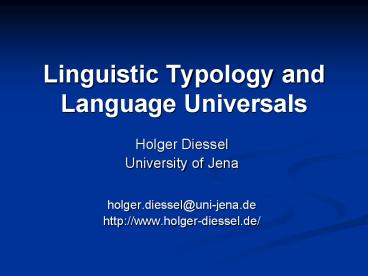Linguistic Typology and Language Universals - PowerPoint PPT Presentation
1 / 17
Title:
Linguistic Typology and Language Universals
Description:
Linguistic Typology and Language Universals. Holger Diessel. University of Jena ... Introduction to the field of linguistic typology ... – PowerPoint PPT presentation
Number of Views:2829
Avg rating:3.0/5.0
Title: Linguistic Typology and Language Universals
1
Linguistic Typology and Language Universals
- Holger Diessel
- University of Jena
- holger.diessel_at_uni-jena.de
- http//www.holger-diessel.de/
2
English - German
3
English - German
(1) Wenn er käme (2) If he came
4
English - German
(1) Er ging vorsichtig die Treppe
hinunter. (2) He careful-ly walked down the
stairs.
5
English - German
(1) Gehst du nach Hause? (2) Are you going home?
6
English - German
(1) Er wird dich anrufen, wenn er deine Mail
bekommen hat. (2) He will call you if he has
gotten you email.
7
English - German
Weak verbs Strong verbs lachen-lachte-gelacht
schreiben-schrieb-geschrieben laugh-laughed-laugh
ed write-wrote-written
8
English - German
(1) hat geschrieben has written (2) wird
schreiben will write
9
Universals
- All languages have vowels and consonants
- All languages have nouns and verbs
- All languages have demonstratives
10
Universals
- Some languages indicate grammatical relations by
word order, others indicate grammatical relations
by morphological means like case suffixes. - Some languages place all nominal modifiers before
the head noun, others place all nominal modifiers
after he head noun.
11
Universals
SUBJ
(1) The man who slept (2) The man who(m) I
met (3) The man who I talked about (4) The
man whose friend disappeared
OBJ
OBL
GEN
12
Universals
The Noun Phrase Accessibility Hierarchy SUBJ gt
OBJ gt OBL gt GEN
If a language allows for the formation of a
relative clause at a certain point on the
hierarchy, it also allows for the formation of
all relative clauses higher up on the hierarchy,
while relative clauses lower on the hierarchy may
not be permissible. Keenan and Comrie 1977
13
Topics
- Introduction to the field of linguistic typology
- Functional-cognitive explanations for linguistic
structure Why is language the way it is? - The structure of English from a cross-linguistic
point of view
14
Syllabus
- Language families, sampling, types of universals
- Nominal and verbal categories
- Morphological marking
- Word order
- Case marking and grammatical relations
- Complex sentences
- Animacy hierarchy
- Markedness
15
Readings
Comrie, Bernard. 1989. Language Typology and
Linguistic Universals. Chicago The University
of Chicago Press. (second edition) Croft,
William. 1990. Typology and Universals.
Cambridge Cambridge University Press. (first
edition) Givón, Talmy. 1984/1990. Syntax. A
functional-typological Introduction. Vols. 1-2.
Amsterdam John Benjamins. Shopen, Timothey (ed.)
1985. Language Typology and Syntactic
Description. Vols. 1-3. Cambridge Cambridge
University Press. Whaley, Lindsay J. 1997.
Introduction to Typology. The Unity and
Diversity of Languages. Thousands Oaks Sage.
16
Requirements
- Term paper
- Short report
- Three assignments
17
Reference grammars
(1) Lobala (Niger-Congo Zaire) Moto me
t-a-iká mo-ph? man DEM NEG-3s-PST C1-give
ná baphalnága ná ntóma and money
and food The man didnt give him either money
or food. (2) Hixkaryana (Carib
Brazil) Apaytara y-ari-hira nexe-ye wekoo chic
ken 3S/3S-take-NEG be-DPST hawk The hawk didnt
take the chicken.































